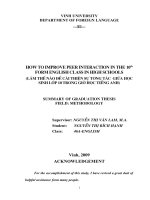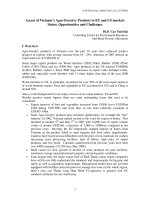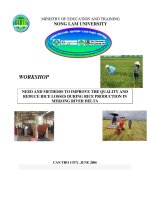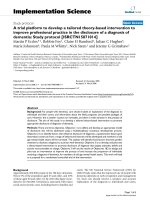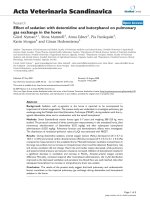ACTUALITY OF VIETNAM’S SUGARCANE AND SOLUTIONS TO IMPROVE SUGAR PRODUCTIVITY IN THE FUTURE
Bạn đang xem bản rút gọn của tài liệu. Xem và tải ngay bản đầy đủ của tài liệu tại đây (159.95 KB, 7 trang )
International Symposium, China, 2006
ACTUALITY OF VIETNAM’S SUGARCANE AND SOLUTIONS
TO IMPROVE SUGAR PRODUCTIVITY IN THE FUTURE
Dr. Nguyen Duc Quang, MSc. Ha Dinh Tuan
Sugar and Sugarcane Research and Development Center, Vietnam
Mobile phone: (84) 913867107; Office: (84)650580552; Private: (84)650817203
FAX: (84)650562267; E-mail:
1. INTRODUCTION
Sugarcane-growing is a long standing in Vietnam, however sugarcane industry has
been developing in recent years. There was lay down as a policy the achievement of 1.0
million tons of sugar per year in 2000, which is satisfied with demand of Vietnam (capita is
estimated from 8 to 10 kg). Based on this program, many sugar mills are debut with different
technology. The great challenge to Vietnam’s sugarcane is becomes a membership of world
trade organization (WTO), which is higher violent competition for cost. Recently (from 2000
to year 2005), there were 44 sugar mills with 85-93 percentage of original capacity (in the
2002/2003 season it was highest), it achieved more than 1.0 million tons of sugar per year.
The biggest capacity processing is 8,000 tons/day (1 sugar mill) and the lowest is 500
tons/day (2 sugar mills), most capacity processing is from 1,000 to 1,800 tons/day. However,
only 37 factories have been working in 2005/2006 season and 7 factories were closed due to
technologically backward or lack of raw materials. According to Ministry of agriculture and
Rural Development for the planning to 2010 (see Appendix 1), total capacity processing will
expand to 105,100 tons/day (82,150 tons/day is present). The great problem is interested in
raw materials and sugarcane zones, how to do in order to assure enough raw materials for
factories working at full capacity in the future, while there are many effective factors to yield
such as insects, diseases, weed, etc.
The plan of Vietnam’s sugarcane in the future is stabilizing concentrate areas, but
concurrent with increase cane productivity and quality of sugarcane. There is help for it,
based on Vietnam there are near 900 clones and varieties that were well preserved at Sugar
and Sugarcane Research and Development Centre – SSRDC (formerly Institute of sugarcane
and sugar research - ISSR). Many clones or varieties have good characters such as drought
resistance, pest resistance and high quality, etc. These are important materials for crossing in
the future. The results of collusion are going to supply suitable varieties in different regions of
cultural sugarcane industry.
2. ACTUALITY OF VIETNAM’S SUGARCANE
2.1 Sugar processing
Actually, 37 sugar mills in present are arranged with new mode to come into
operations as follows:
- Six sugar mills are joint ventures with 100% of funds from foreign investment.
- Twenty-one sugar mills are published.
- One sugar mill is selling the shares.
- Three sugar mills are submitting the project for privatize.
- One sugar mill is preparing to be privatized.
- Three sugar mills are suggesting government which is allow schedule project for sell.
- Two sugar mills have not enough condition to be privatized.
218
Gross sugar yield is 754,200 tons in 2006, including 230,000 tons of RE and other
sugars are 524,200 tons, reduce 16.3% comparison with 2005. Besides, 150,000 tons of sugar
manufactured by small semi-manual factories.
2.2 Raw materials
In 2005/2006 season, there were 193,500 hectares; it is reduced 17.8% in comparison
with 2004/2005 season (only 70% of plan). Although higher cane productivity was compared
with year 2005, but it is satisfying 69.1% of raw materials for processing of 37 sugar-mills in
Vietnam, sugarcane productivity in every zone as follows:
- The highland of the North-Eastern: 47.0 tons of cane per hectare.
- North central part: 53.7 tons of cane per hectare.
- The Central Coast, the South-Eastern: 48.8 tons of cane per hectare.
- The Mekong River Delta region: 72.2 tons of cane per hectare, the factories processing
are working at full or exceeding capacity.
In the North, South and the Centre have settled in sugarcane areas with high level of
intensive cultivation of Farmers. However, in the North and the Centre the cane productivity is
lower than in other regions because drought and storms damage to crop (high quality is excepted),
while the climate and terrain in the South are advantages for growth of sugarcane, special
Mekong River Delta region is high yield, some areas are achieved more than 200 tons of cane
per ha. However, the quality of this region is lower than of others caused by early harvest
(immature cane) and flooding. Most early harvest is due to avoidance from flood and unstable
prices of raw materials. Moreover, due to lack of raw materials for processing sugar, many
companies were buying chaotic cane without interest in quality. Which is leading low quality and
compete to raw materials contributed to low cane yield.
Besides, yield and quality of sugarcane are as low as close correlation to insect, diseases
and weed. Where:
- Insect: There are 27 common species (see Appendix 2), including 7 great importances
such as Sesamia inferens Walker, Phragmatoecia castaneae Hubner, Chilo sacchariphagus
Bojer, Chilo infuscatellus Snellen, Alissonotum impresicolle Arrow (in the Centre),
Odontotermes spp. (high land) and Patanga succincta L. in several South-Eastern. Insect
control by several main methods like: cultural methods, bio-control (to release Trichogramma
sp.), resistant varieties of bores (VN84-4137, ROC16, K84-200, etc.), chemical methods
(apply Basudin 10G just after planting).
- Diseases: There are 52 common diseases in Vietnam (see Appendix 3a&b), some of
them are bad effect to yielding cane such as smut, ratoon stunting (RSD), red rot, bokkah boeng,
white leaf (WLD), yellow leaf syndrome (YLS), yellow spot, white speck, etc. Little
Vietnamese farmer has been interested in sugarcane diseases, because they are planted by
their farming habits. However, many local habits have eliminated several diseases such as: to
dip seedcane in water for 24 hours; to choose careful seedcane, etc. Besides, seedcane is
treated in hot water used to supply planting material for commercial fields. Hot water
treatment at 50oC for 2 hours has been commonly used by methods after that transferred to
fungicide solution (5‰ of Benlat-C or Dithan-M) for 15 minutes.
- Weed: There are 35 common species in sugarcane (see Appendix 4); some major species
are great important and difficult to control such as Cynodon dactylon Pers.,Cyperus rotundus L.,
Borreria latifolia S., Dactyloctenium aegyptium B. Eleusine indica Gaertner, Imperata
cylindrica L., Mimosa pudica L., etc. The farming habits of Vietnamese are most manual care
of sugarcane. Consequently, weed control is carrying out by hand, hoe, sickle, etc. Chemical
method has been used in the South-Eastern and several areas of Centre. Chemical Diuron,
Glyphosate, 2.4D and Paraquat are common herbicides for control in sugarcane.
219
2.3 Sub-products from sugarcane
In 2006, sugar processing productivity fertilizers from bagasse was 180,000 tons,
polly wood was 18,000 m3 and 30 million litters of alcohol were distilled by molasses.
Moreover, sugar mills are invested in processing and producing paper, candy, animal feeds
and electricity, etc.
3. SOLUTIONS TO IMPROVE SUGAR PRODUCTIVITY
Government will control and prevent sugar from illegal import.
Total capacity processing will expand from 82,150 (now) to 105,100 tons/day in 2010.
Long-term programming and stabilizing concentrate areas; step up intensive
cultivation with increased cane productivity and high quality of sugarcane. Target is going to
exceed 70 tons/ha with higher 11% of CCS in year 2010 and achieve 100 tons/ha with higher
12 % of CCS in year 2020.
The irrigation systems will consolidate and upgrade in drought regions.
Mekong delta region: To dam up food control dike at some areas of which long
harvest helps for increasing sugar productivity per ha. Besides, to plant early mature varieties
in the sugarcane zones are flooding every year.
Government will establish the policy on insurance against prices and stable prices of
raw materials
To step up mechanical cultivation and harvest is essential to modern cultivation in the
future.
Selections of suitable varieties are harvesting time as early, mid and late; simultaneous
combination of resistance to pests, flood, drought and salt, acid soil, etc. Along with domestic
varietal selections will import new varieties from foreign, from exotic varieties are going to be
carefully retested before release to reality production. However, ratio of exotic varieties is
lower than 30% in area.
To invest in expenditure for transferring new varieties, modern cultivation and
advance of technology. There are 70% of new varieties with high yield and quantity (30% in
present). Carrying out ratio of sensible new varieties increases about 5% of cane yield per
year.
A system of seedcane treatment is necessary to clean setts for supply planting material
for commercial fields in each sugarcane area.
REFERENCE
1. Diep, Do Ngoc. 2002. Research for bores in sugarcane and bores control in South-Eastern
(Thesis of PhD.). Hanoi University Agriculture No 1, Hanoi, Vietnam.
2. Ministry of agriculture and rural development of Vietnam, 2006. Report of closing
sugarcane in 2005-2006 season. Vietnam’s sugarcane industry conference 8/2006.
3. Quang, Nguyen Duc. 2004. Research for Sesamia sp. on sugarcane in the South-eastern
and thier coltrol method (Thesis of PhD), Vietnam Agricultre Science Institute, Hanoi
Vietnam
4. Quang, Nguyen Duc. 2006. Selection of varieties and integrated crop management (ICM)
which are help for increase yielding cane and cane quality (period 2006-2010). Sugar and
sugarcane research and development centre, Vietnam.
5. Tuan, Ha Dinh. 2003. Investigation of sugarcane diseases in the new exotic varieties and
exploratory development of major diseases in common sugarcane varieties in the Eastern
South (Thesis of MSc.). University of Agriculture and Forestry of Ho Ch Minh City,
Vietnam.
220
6. Tuan, Ha Dinh. 2006. Preliminary results of studies on fungal diseases damaging
sugarcane in the Eastern South. The journal of protection crop No 2, April /2006, pp. 1-5,
Vietnam.
Appendix 1: The planning of sugar mills are expand capacity to 2010 (tons per day)
No
I.
1.
2.
3.
4.
5.
6.
7.
8.
9.
10.
11.
12.
13.
14.
15.
16.
17.
18.
19.
20.
21.
22.
23.
II.
24.
25.
26.
27.
28.
29.
30.
31.
32.
33.
34.
35.
36.
37.
Present capacity
Capacity of
(2005/2006 season)
year 2010
Sugar mills are keep intact capacity
47,800
47,800
Tuyen Quang
700
700
Cao Bang
700
700
Son La
1,000
1,000
Hoa Binh
700
700
Vietnam-Taiwan
6,000
6,000
Song Lam
500
500
Quang Phu
2,500
2,500
Pho Phong
1,500
1,500
Tuy Hoa
1,250
1,250
Ninh Hoa
1,250
1,250
Cam Ranh
6,000
6,000
An Khe
2,000
2,000
Bouborn Gia Lai
1,800
1,800
Kon Tum
1,000
1,000
Daknong
1,000
1,000
Phan Rang
500
500
La Nga
2,000
2,000
Nuoc Trong
900
900
Bouborn Tay Ninh
8,000
8,000
Hiep Hoa
2,000
2,000
Nagajuna
4,500
4,500
Kien Giang
1,000
1,000
Thoi Binh
1,000
1,000
Sugar mills are expand capacity
34,350
57,300
Son Duong
1,000
2,000
Lam Son
6,500
12,500
Nong cong
1,500
2,000
Song Con
1,250
2,000
Nghe An – Tate & Lyle
7,500
12,000
Binh Dinh
1,500
2,500
KCP
2,500
4,000
333 Daklak
700
1,000
Tay Ninh
3,500
6,000
Ben Tre
1,500
2,500
Tra Vinh
1,500
2,500
Phung Hiep
1,800
2,300
Vi Thanh
1,800
3,000
Soc Trang
1,800
3,000
Total
82,150
105,100
(Source: Ministry of agriculture and Rural Development of Vietnam, 2006)
Sugar mill
221
No
I
1.
2.
3.
4.
5.
6.
7.
II
8.
9.
10.
11.
12.
13.
14.
III
15.
16.
17.
18.
19.
20.
21.
22.
IV
23.
24.
25.
26.
27.
No
I.
1.
2.
3.
II.
1.
2.
3.
4.
5.
222
Appendix 2: Common insects in sugarcane in Vietnam
Insect
Family
Bore group
Sesamia inferens Walker
Phragmatoecia castaneae Hubner
Scirpophaga nivella Fabr.
Eucosma schistaceana Snellen
Chilo sacchariphagus Bojer
Chilo infuscatellus Snellen
Chilo auricilius Dudgeon
Harmful leaf group
Patanga succincta L.
Trilodiphia japonica Sausruse
Oedaleus infernilis Sausruse
Spodoptera mauritia Fabr.
Mythimna separata Walker
Hypomeces squamosus Fabr.
Platymycterus sieversi Reit
Sting-suck group
Ceratovacuna lanigera Zehnt
Trionymus sacchari Cockerell
Rhopalosiphum maidis Fitch
Eoeurysa flavocapilata Muir.
Phaenacanhtha marcida Horvath
Neraza viridula L.
Scotinophora sp.
Thrip (Fulmekiola) seratus Kobus
Harmful root
Alissonotum impresicolle Arrow
Anomala expensa Bates
Anomala cupripes Hope
Gryllotalpa formosana Shiraki
Odontotermes spp.
* Note: +++: High appearance;
+: Little appearance;
Appearance
Noctuidae
Cossidae
Pyralidae
Eucosmidae
Pyralidae
Pyralidae
Pyralidae
+++
++
++
++
++
-
Acrididae
Acrididae
Acrididae
Noctuidae
Noctuidae
Acrididae
Acrididae
+
+
-
Aphididae
Aphididae
Aphididae
Delphacidae
Pyrhocoridae
Pyrhocoridae
Pyrhocoridae
Thripidae
++
+
++
+
+
+
Scarbacidae
Scarbacidae
Scarbacidae
Gryllotapidae
Macrotermitidae
++: Moderate appearance
- : Rare appearance
Appendix 3a: Common diseases in sugarcane in Vietnam
Common name
Latin name
Uncertain etiology
Apex rot
Ablinism
Chlorotic streak
Caused by virus and phytoplasma
Fiji
Fijivirus
Mosaic
Sugarcane Mosaic Virus
Streak
Sugarcane Streak Virus
Yellow leaf syndrome (YLS)
Emergentvirus, Polerovirus,
White leaf (WLD)
Phytoplasma
+
+
+
+
++
Appearance
++
+
IV.
1.
2.
Caused by Bacteria
Ratoon stunting (RSD)
Gumming
3.
4.
5.
V.
VI.
VII.
Leaf scald
Red stripe
Spindle rot
Nematodes
Hemiparasitic plant
Nutritional, environmental and
chemical disorder
High temperature
Drought
Boron deficiency
Copper deficiency
Nitrogen deficiency
Phosphor deficiency
Iron deficiency
Herbicide effect (Paraquat)
* Note: +++: High appearance;
+: Little appearance;
1.
2.
3.
4.
5.
6.
7.
8.
Leifsonia xyli subsp. xyli
Xanthomonas campestris pv.
vasculorum
Xanthomonas albilineans
Pesdomonas rubrilineans
Acidovorax avenae subsp. Avenae
++
+
+
-
+++
+++
++
++
++: Moderate appearance
- : Rare appearance
Appendix 3b: Common diseases (fungi) in sugarcane in Vietnam
No Common name
1 Binding
2
3
4
5
6
7
8
9
10
11
12
13
14
15
16
17
18
19
Latin name
Myriogenospora
aciculispora
Leaf spot
Curvularia lunata
Pineapple
Ceratocystis paradoxa
Leaf splitting
Scleropora miscanthi
Root rot
Pythium spp.
Rind
Phaeocytostroma
sacchari
Banded sclerotial Rhizoctonia solani
Dry top rot
Ligniera vascularum
Zonate leaf spot
White speak
Ring spot
Bokka boeng
Zonate leaf spot
Smut
Flora smuts
Flora smuts
Common rust
Red rot of the
leaf sheath
20 Leaf scorch
21 Red spot
22 Sooty mould
Class
Pyrenomycetes
Order
Clavicipitales
Appearance
-
Euascomycetes
Oomycetes
Oomycetes
Oomycetes
Coelomycetes
Pleosporales
Ophiostomatales
Peronosporales
Peronosporales
Erysiphales
+
-
Ceratobasidiales
-
-
Gloeocercospora sorghi
Elsinoe sacchari
Leptosphaeria sacchari
Fusarium moniliforme
Cytospora sacchari
Marasmius sacchari
Ustilago scitaminea
Ustilago cruenta
Sporisorium cruentum
Puccinia melanacephala
Corticium rolfsii
Hymenomycetes
Plasmodiophoromycetes
Dothideomycetes
Ascomycetes
Ascomycetes
Ascomycetes
Ascomycetes
Basidiomycetes
Basidiomycetes
Basidiomycetes
Basidiomycetes
Basidiomycetes
Basidiomycetes
Pleosporales
Myriangiales
Dothideales
Hypocreales
Diaporthales
Agaricales
Utilaginales
Utilaginales
Utilaginales
Uredinales
Polyporales
++
+++
+
+
++
+
++
Stagonospora sacchari
Mycovellosiella vaginae
Capnodium sp.
Deuteromycetes
Deuteromycetes
Deuteromycetes
Coelomycetes
Dothideales
Dothideales
++
+++
+
223
23
24
25
26
27
28
Sooty mould
Eye spot
Brown stripe
Brown spot
Yellow spot
Red rot
Fumago sacchari
Bipolaris sacchari
Bipolaris stenospila
Cercospora longipes
Cercospora koepkei
Colletotrichum falcatum
* Note: +++: High appearance;
+: Little appearance;
No
1.
2.
3.
4.
5.
6.
7.
8.
9.
10.
11.
12.
13.
14.
15.
16.
17.
18.
19.
20.
21.
22.
23.
24.
25.
26.
27.
28.
29.
30.
31.
32.
33.
34.
35.
224
Deuteromycetes
Deuteromycetes
Deuteromycetes
Deuteromycetes
Deuteromycetes
Deuteromycetes
Dothideales
Dematiales
Dematiales
Moniliales
Moniliales
Melanconiales
+
++
+
+++
+++
++: Moderate appearance
- : Rare appearance
Appendix 4: Common weed in sugarcane in Vietnam
Latin name
Family
Ageratum conyzoides L.
Acanthaceae
Amaranthus hybridus L.
Amaranthacae
Amaranthus spinosus L.
Amaranthacae
Centella asiatica (L.) Urb.
Apiaceae
Boerhavia diffusa L.
Basellaceae
Borreria latifolia Schum.
Boraginaceae
Chloris barbata Sw.
Poacea
Commelina benghalensis L.
Commelinaceae
Commelina diffusa Burm.
Commelinaceae
Cynodon dactylon Pers.
Poaceae
Cyperus compressus L.
Cyperaceae
Cyperus difformis L.
Cyperaceae
Cyperus rotundus L.
Cyperaceae
Dactyloctenium aegyptium B.
Cyperaceae
Digitaria cialiaris (Retz) Koel.
Poaceae
Digitaria setigera R. & S.
Poaceae
Eleusine india Gaertner
Poaceae
Euphorbia heterophylla L.
Euphorbiaceae
Euphorbia thymifolia L.
Euphorbiaceae
Imperata cylindrica L.
Poaceae
Echinocholoa colona (L.) Link.
Poaceae
Lantana camara L.
Asteraceae
Leptochloa chinensis (L) Nees.
Poaceae
Pennisetum polystachyon (L.) Schult.
Poaceae
Mimosa invisa Mart. Ex Colla
Leguminosae
Mimosa pudica L.
Leguminosae
Panicum maximum Jacquin
Poaceae
Panicum reptans L.
Poaceae
Setaria palmifolia (Koen.) Stapf.
Poaceae
Polygonum spp.
Polygonaceae
Sida acuta Burman
Malvaceae
Oxalis corniculata L.
Oxalidaceae
Urena lobota L.
Malvaceae
Portulaca oleracea L.
Portulacaceae
Ipomoea aquatica Forssk.
Covolvulaceae
* Note: +++: High appearance;
++: Moderate appearance
+: Little appearance;
- : Rare appearance
Appearance
+
+
+++
++
+
+
+
+
+
++
++
+
+
++
-

